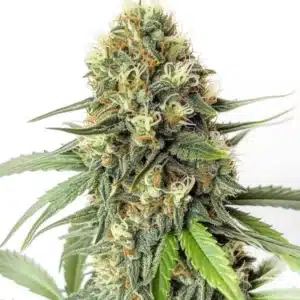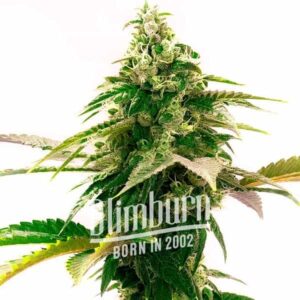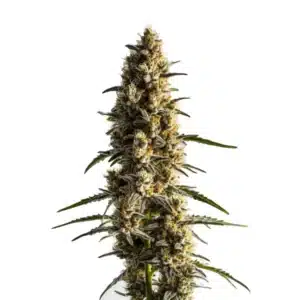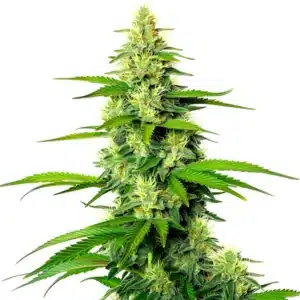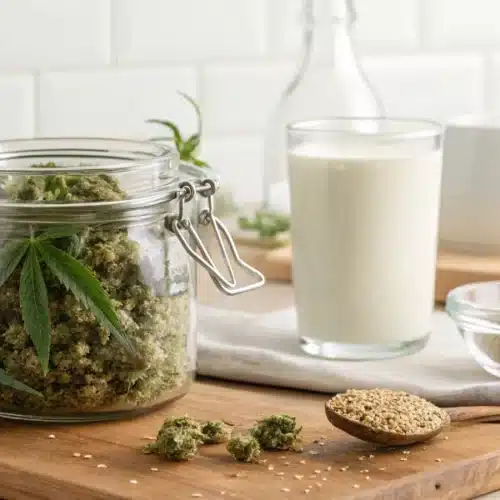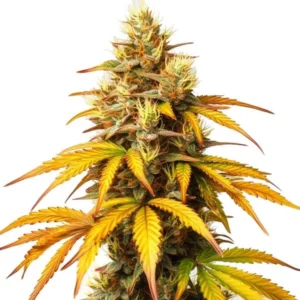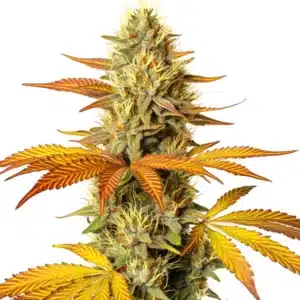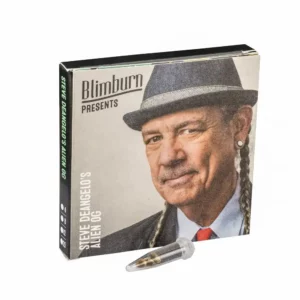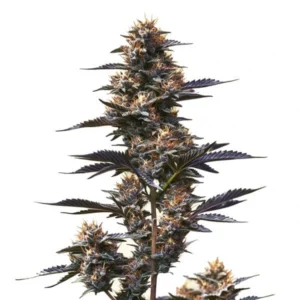Steve’s Hellfire OG Strain Description
Steve’s Hellfire OG is an exceptional cannabis strain that has quickly gained recognition among cannabis enthusiasts for its potent effects and unique characteristics. This strain stands out due to its high THC content, remarkable yields, and complex flavor profile, making it a top choice for both recreational and medicinal users.
Recommended Strains
Steve's Hellfire OG
 THC: 20%
THC: 20% Type of seed: Feminized
Type of seed: Feminized Phenotype: Mostly Hybrid
Phenotype: Mostly Hybrid Day to flower: 8 - 10 weeks
Day to flower: 8 - 10 weeks
Steve’s Hellfire OG is a carefully crafted hybrid, bringing together the best traits of its parent strains, SFV OG Kush and Rascal OG. The result is a balanced yet powerful hybrid that leans slightly toward its Indica heritage, offering both mental stimulation and deep physical relaxation. The buds of Steve’s Hellfire OG are dense and coated in a generous layer of trichomes, giving them a frosty, almost fiery appearance. These buds exhibit hues of green and orange, often with subtle purple undertones, depending on the growing conditions.
One of the defining features of Steve’s Hellfire OG is its intense and multifaceted flavor profile. Users can expect a blend of earthy pine with hints of lemon and diesel, underpinned by a pungent, spicy aroma. The terpene profile is dominated by Myrcene, Limonene, and Caryophyllene, contributing to its potent effects and rich taste. With THC levels ranging around 20%, Steve’s Hellfire OG is not for the faint-hearted but offers a truly memorable experience for those seeking a powerful high.
Promos & Deals
Environmental Requirements for Growing Steve’s Hellfire OG
Creating the perfect environment for Steve’s Hellfire OG is crucial to activating its full potential. This strain thrives in a controlled environment where temperature, humidity, and light can be precisely regulated. The specific environmental needs of Steve’s Hellfire OG will help ensure a successful grow, whether you’re cultivating indoors or outdoors.
Steve’s Hellfire OG flourishes in a temperate to slightly warm climate, ideally with daytime temperatures ranging between 70-80°F (21-27°C) and cooler nighttime temperatures around 60-70°F (15-21°C). Maintaining a stable environment with consistent temperature and humidity levels is vital to prevent stress and encourage healthy development. High humidity levels during the vegetative stage should be gradually reduced as the plants transition into the flowering phase to avoid issues like mold or mildew.
Indoors, Steve’s Hellfire OG requires high-quality LED grow lights or HPS lamps that provide intense light without excessive heat. During the vegetative stage, an 18-20 hour light cycle is ideal, while a 12/12 light cycle should be maintained during flowering to encourage robust bud development. Proper air circulation is essential to prevent heat build-up and ensure the plants receive adequate CO2, which is crucial for photosynthesis.
For outdoor growers, Steve’s Hellfire OG thrives in a sunny location with plenty of direct sunlight. This strain is well-suited to regions with long, warm summers. If you live in an area with a shorter growing season or cooler temperatures, consider using a greenhouse or light deprivation techniques to extend the growing period and protect your plants from the elements. Outdoor plants can grow large, so ensure they have enough space to spread out and receive ample light.
Setting Up The Growing Cannabis Space
Before you embark on cultivating Steve’s Hellfire OG, setting up a well-organized and efficient grow space is crucial. Whether you choose to grow indoors or outdoors, the setup will play a significant role in the overall success of your cannabis cultivation journey.
Indoor Cannabis Cultivation
When growing Steve’s Hellfire OG indoors, it’s important to create a controlled environment that meets the specific needs of this strain. Start by selecting a grow tent or a dedicated grow room that offers sufficient space for your plants to expand both vertically and horizontally. Proper ventilation is key; install an exhaust system with a carbon filter to manage odors and maintain fresh airflow, which helps regulate temperature and humidity.
Lighting is another critical factor. Steve’s Hellfire OG benefits from intense light during both the vegetative and flowering stages. High-quality LED lights or HPS lamps are recommended, and reflective materials like Mylar should be used to maximize light distribution. Ensure that the lights are positioned at an appropriate distance to avoid burning the plants while still providing enough intensity for optimal growth.
Choosing the right growing medium is essential. Steve’s Hellfire OG performs well in both soil and hydroponic setups. If using soil, opt for a high-quality, well-draining soil mix with a balanced pH level of around 6.0-6.5. For hydroponic systems, maintain a consistent nutrient solution with appropriate levels of nitrogen, phosphorus, and potassium to support each stage of growth. Regular monitoring of pH and EC levels is crucial to prevent nutrient imbalances.
Outdoor Cannabis Cultivation
Steve’s Hellfire OG can also thrive in an outdoor setting, provided the climate and conditions are favorable. Begin by selecting a sunny location with well-draining soil rich in organic matter. If your native soil is less than ideal, consider using large containers or raised beds filled with a custom soil mix to ensure your plants have the best possible start.
Outdoor plants can grow quite large, especially in ideal conditions, so spacing is important. Give each plant enough room to spread out and receive adequate sunlight throughout the day. Regularly check the plants for any signs of nutrient deficiencies or pest issues, which can be more challenging to control outdoors. Using organic fertilizers and pest control methods can help maintain plant health and protect the environment.
As Steve’s Hellfire OG develops dense and heavy buds, supporting the branches with stakes or trellises is recommended. This prevents the branches from breaking under the weight of the buds and ensures better air circulation, reducing the risk of mold or mildew. Additionally, consider using a light deprivation technique if you need to force flowering earlier or protect the plants from excessive rain during the late flowering stage.
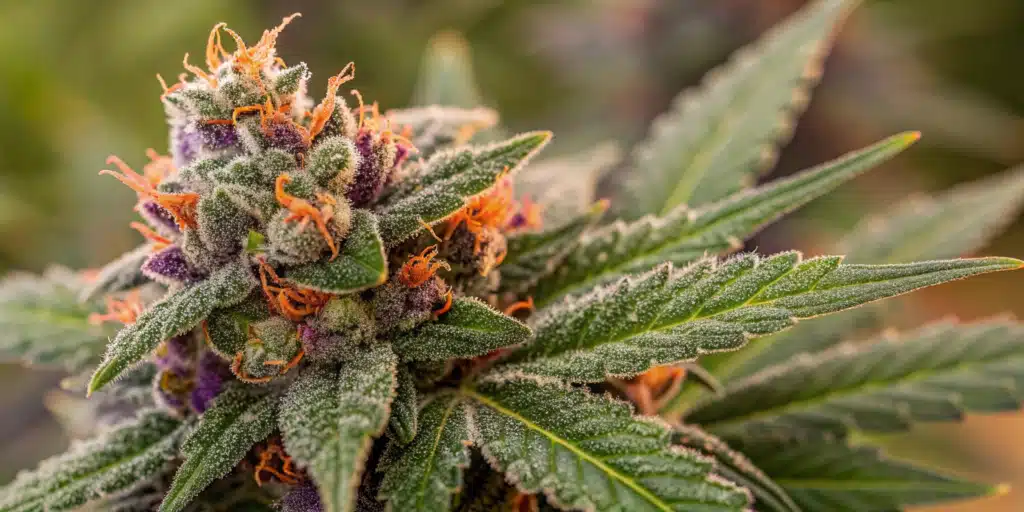
Propagation and Germination of Steve’s Hellfire OG
Getting Steve’s Hellfire OG off to a strong start begins with successful germination and propagation. Proper techniques during these early stages are crucial to ensure healthy and vigorous plants.
1. Start by selecting high-quality Steve’s Hellfire OG feminized seeds from a reputable seed bank like Blimburn Seeds. This ensures genetic stability and a higher likelihood of female plants, which produce the desired buds.
2. Begin the germination process by soaking the seeds in distilled water or placing them between damp paper towels for 24-48 hours. Maintain a temperature between 70-85°F (21-29°C) and keep the seeds in a dark, undisturbed location during this time.
3. Once the seeds have developed taproots, transfer them carefully to a pre-moistened growing medium, such as seedling trays or small pots filled with a light, well-draining soil mix. Handle the seeds gently to avoid damaging the delicate roots.
4. Place the seedlings in a warm, humid environment with gentle airflow. Maintain a temperature around 75-80°F (24-27°C) and a humidity level of 60-70% to encourage healthy root development and prevent drying out.
5. Provide indirect light to the seedlings during the first few days, gradually increasing light intensity as they grow. Avoid exposing them to intense light or heat too early, as this can cause stress or damage.
6. Once the seedlings have developed a few sets of true leaves, they are ready to be transplanted into larger pots or directly into the ground, depending on your growing setup.
Following these germination and propagation steps will set your Steve’s Hellfire OG plants up for success, ensuring they have a strong foundation for vigorous growth and abundant yields.
Vegetative Phase of Steve’s Hellfire OG Strain
The vegetative phase is a critical period in the growth cycle of Steve’s Hellfire OG, during which the plants build the structure necessary for a bountiful harvest. Here’s how to ensure your plants thrive during this stage:
Lighting: During the vegetative phase, Steve’s Hellfire OG requires an extended period of light each day, typically between 18-20 hours. High-quality LED grow lights or HPS lamps are essential to provide the necessary light intensity and spectrum, promoting robust vegetative growth.
Nutrition: Your plants will need a balanced diet rich in nitrogen during the vegetative stage, as this nutrient is vital for leaf and stem development. Use a cannabis-specific fertilizer that provides the right balance of nutrients, and follow the manufacturer’s instructions carefully to avoid overfeeding or nutrient burn. Regularly monitor the plants for any signs of deficiencies, such as
yellowing leaves or stunted growth, and adjust your feeding schedule accordingly. It’s important to provide the plants with the nutrients they need without overwhelming them, ensuring a steady and healthy growth pattern.
Watering: Proper watering practices are crucial during the vegetative phase. Water your Steve’s Hellfire OG plants when the top inch of the soil feels dry to the touch. Avoid overwatering, as this can lead to root rot and other moisture-related issues. It’s essential to allow the soil to dry out slightly between waterings, but make sure the plants do not experience prolonged drought conditions.
Training: Implementing training techniques during the vegetative phase can significantly improve your yields and manage plant height. Low-stress training (LST), topping, and super cropping are effective methods for controlling the plant’s shape and size. These techniques encourage the development of multiple colas and an even canopy, maximizing light exposure and enhancing bud production later in the flowering phase.
Pruning: Regular pruning is necessary to remove any lower leaves or branches that receive little light. This not only improves air circulation but also directs the plant’s energy toward the top colas, where bud development will be most vigorous. Additionally, removing any damaged or diseased leaves early on can prevent the spread of potential issues.
By providing optimal conditions and care during the vegetative phase, your Steve’s Hellfire OG plants will develop strong and healthy structures, setting the stage for a productive flowering phase and a rewarding harvest.
Flowering Phase of Steve’s Hellfire OG Strain
The flowering phase is when Steve’s Hellfire OG truly comes into its own, producing the dense, resinous buds that this strain is famous for. Proper care during this stage is crucial to maximize yield and potency.
Lighting: To initiate the flowering phase, switch your light cycle to 12 hours of light followed by 12 hours of uninterrupted darkness. Maintaining this consistent schedule is key to triggering and sustaining the flowering process. Steve’s Hellfire OG plants require intense light during this period, so ensure your grow lights provide sufficient coverage and intensity. Position the lights close enough to penetrate the canopy but not so close that they cause heat stress or light burn.
Nutrition: As the plants transition from vegetative growth to flowering, their nutritional needs shift. Reduce nitrogen levels and increase phosphorus and potassium intake, as these nutrients support bud development and overall flowering health. Use a bloom-specific fertilizer to provide the necessary nutrients, and continue to monitor the plants for signs of deficiencies or nutrient lockout.
Temperature and Humidity: During the flowering phase, it’s important to maintain slightly cooler temperatures, ideally around 65-75°F (18-24°C), to encourage resin production and prevent heat-related stress. Humidity levels should be lowered to around 40-50% to minimize the risk of mold or bud rot, especially as the buds become denser.
Support: As Steve’s Hellfire OG produces heavy buds, the branches may struggle to support their weight. Use stakes, trellises, or plant ties to provide additional support and prevent the branches from bending or breaking. This support also helps improve light penetration and airflow, both of which are essential for healthy bud development.
Flowering Time: Steve’s Hellfire OG typically has a flowering time of 8-10 weeks, depending on the specific growing conditions and phenotype. Keep a close eye on the development of the buds and trichomes as the plants mature. Using a magnifying glass or a jeweler’s loupe, monitor the trichomes for color changes. Harvesting when the trichomes are mostly cloudy with some turning amber will yield the most potent and flavorful buds.
Throughout the flowering phase, be vigilant about checking for pests and diseases, as the dense buds can be prone to infestations. Implement integrated pest management (IPM) practices, such as using beneficial insects or organic pest control methods, to keep your plants healthy and thriving until harvest time.
Cannabis Fertilization and Nutrition
Proper fertilization and nutrition are key to maximizing the growth, yield, and quality of Steve’s Hellfire OG. A well-balanced feeding regimen tailored to the needs of this strain will ensure robust plant health and abundant harvests.
Choosing the Right Fertilizer: Select a high-quality cannabis-specific fertilizer that provides a complete range of macro and micronutrients. During the vegetative stage, focus on fertilizers high in nitrogen to support strong leaf and stem growth. As the plants transition to flowering, switch to a bloom-specific formula rich in phosphorus and potassium, which are crucial for bud development.
Feeding Schedule: Follow the manufacturer’s recommended feeding schedule, but always start with a lower concentration and gradually increase it based on the plant’s response. Overfeeding can lead to nutrient burn, while underfeeding can result in deficiencies that stunt growth. Regularly monitor the plants for signs of nutrient issues, such as yellowing leaves, and adjust the feeding regimen as needed.
Supplements and Additives: In addition to your base nutrients, consider incorporating supplements and additives that enhance specific aspects of plant development. Common supplements include bloom boosters, which increase bud size and density, as well as beneficial microbes that improve nutrient uptake and overall soil health. Some growers also use enzymes to break down dead root material and keep the root zone healthy.
During the final weeks of the flowering phase, it’s important to flush the plants with pure water to remove any excess nutrients from the soil or growing medium. This process helps improve the flavor and overall quality of the buds by eliminating any harsh chemical residues.
By providing Steve’s Hellfire OG with the right nutrition at each stage of growth, you’ll ensure that your plants reach their full potential, delivering potent and flavorful buds come harvest time.
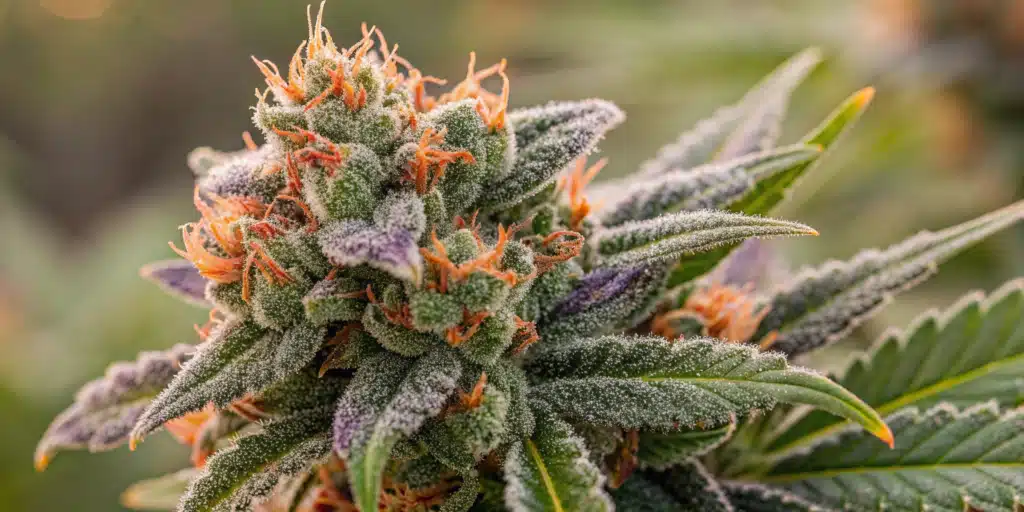
Pest And Disease Control for Cannabis Growing
While Steve’s Hellfire OG is a robust strain, it is not immune to the threats posed by pests and diseases. Implementing a proactive approach to pest and disease control will protect your plants and ensure a successful harvest.
Prevention:
- Regularly inspect your plants for signs of pests, such as spider mites, aphids, or thrips. Early detection is critical to preventing a full-blown infestation.
- Maintain a clean and organized grow space, removing any dead plant material or debris that could harbor pests or pathogens. Sanitize your tools and equipment to reduce the risk of contamination.
- Introduce beneficial insects, such as ladybugs or predatory mites, to your grow space to naturally control pest populations. These insects can help keep harmful pests in check without the need for chemical pesticides.
- Ensure proper airflow and ventilation in your growing area to reduce the likelihood of mold or mildew formation. Keeping the humidity levels within the recommended range during each growth phase is essential for disease prevention.
- Quarantine any new plants or clones before introducing them to your grow area to prevent the spread of pests or diseases.
Corrective Actions:
- If you detect pests, use organic or low-toxicity pest control products specifically formulated for cannabis. These products are designed to be safe for both the plants and the end consumer. Always follow the application instructions carefully.
- For fungal diseases like powdery mildew or botrytis, promptly remove any infected plant material to prevent the disease from spreading. Consider using organic fungicides or natural remedies such as neem oil or a milk spray solution to combat these issues.
- In cases of severe infestations or persistent disease problems, it may be necessary to seek advice from a professional grower or horticulturist who can recommend more specialized solutions.
Harvesting and Curing for Cannabis Growing
Harvesting Steve’s Hellfire OG at the right time and properly curing the buds are critical steps to preserve the strain’s rich flavor, potent effects, and overall quality. Here’s how to do it:
Trichome Maturity: The best way to determine the optimal harvest time is by examining the trichomes on the buds. Use a magnifying glass or a jeweler’s loupe to closely inspect the trichomes. Harvest when the majority of trichomes have turned milky white with a few beginning to turn amber. This indicates that the cannabinoids and terpenes are at their peak potency.
Harvesting: When you’re ready to harvest, use clean, sterilized pruning shears to cut the branches one by one. Handle the buds carefully to avoid damaging the delicate trichomes. Remove any large fan leaves but leave the smaller sugar leaves intact, as they contain valuable trichomes and contribute to the overall bud structure.
Drying: After harvesting, hang the branches upside down in a dark, well-ventilated area with a temperature of 60-70°F (15-21°C) and a humidity level of 50-60%. Proper airflow is crucial to prevent mold and mildew. The drying process usually takes 7-14 days, depending on the environmental conditions. The buds are ready
when the smaller stems snap cleanly instead of bending. At this point, the buds should feel dry to the touch, but not brittle.
Curing: After the drying process, carefully trim the buds from the branches and place them in airtight glass jars. Store the jars in a cool, dark place with a temperature of around 60-70°F (15-21°C) and a humidity level between 58-62%. For the first week, open the jars once or twice a day for a few minutes to allow excess moisture to escape. This “burping” process is essential to prevent mold and ensure a smooth curing process.
Curing typically lasts between 2-4 weeks, but the longer you cure the buds, the better the flavor and potency will develop. Patience during this stage will be rewarded with a smoother smoke, enhanced flavor profile, and a more refined overall experience. Properly cured Steve’s Hellfire OG buds will have a rich, pungent aroma, a sticky texture, and a potent effect that reflects the full potential of the strain.
Is Steve’s Hellfire OG Strain Indica or Sativa?
Steve`s Hellfire OG strain is a balanced hybrid that leans slightly towards its Indica heritage, offering a combination of both Indica and Sativa effects for a well-rounded experience. The exact ratio can vary slightly depending on the specific phenotype, but it generally leans about 60% Indica and 40% Sativa.
This balance makes Steve’s Hellfire OG a versatile strain suitable for a wide range of users. On the Indica side, it delivers deep physical relaxation, making it an excellent choice for unwinding after a long day or for those seeking relief from pain and insomnia. On the Sativa side, it provides a cerebral uplift that can enhance creativity and sociability, without the overwhelming couch-lock effect often associated with pure Indicas.
Overall, Steve’s Hellfire OG offers a well-rounded experience that caters to both recreational and medicinal users, making it a popular choice for those looking for a strain that can deliver a potent and enjoyable high.
Tips for Easy Cannabis Cultivation
For growers seeking an easier cultivation experience, here are some tips to help streamline the process and improve your chances of success with Steve’s Hellfire OG:
- Start with Quality Genetics: Always begin your grow with high-quality seeds from a reputable source. This ensures that your plants have strong, stable genetics, which can make a significant difference in their resilience and overall performance.
- Maintain Consistent Conditions: Keep your growing environment as stable as possible. Fluctuations in temperature, humidity, and light can stress your plants and lead to lower yields or quality. Invest in timers, fans, and climate control systems to help automate and maintain ideal conditions.
- Choose the Right Medium: If you’re new to growing, consider starting with soil, which is more forgiving than hydroponic systems. Soil provides a buffer against nutrient imbalances and is easier to manage for beginners.
- Keep it Simple: Stick to a basic nutrient regimen and avoid overcomplicating your grow with too many additives or techniques. Focus on mastering the fundamentals before experimenting with advanced methods.
- Stay Clean and Organized: A clean grow space reduces the risk of pests and diseases. Regularly sanitize your tools and equipment, and keep your growing area free from clutter and debris.
By following these tips, even novice growers can achieve a successful harvest with Steve’s Hellfire OG, enjoying the rewards of their efforts with a potent and flavorful cannabis crop.
FAQs
How long does it take for Steve’s Hellfire OG to flower?
Steve’s Hellfire OG typically takes around 8-10 weeks to complete its flowering phase. This period may vary slightly depending on the specific growing conditions and the phenotype of the plant. Indoor growers can control the environment more precisely, often leading to a consistent flowering period within this range. For outdoor cultivation, the timing can depend on the local climate, but generally, you should expect to harvest in late September to early October.
What are the ideal growing conditions for Steve’s Hellfire OG?
Steve’s Hellfire OG thrives in a controlled environment with consistent temperatures and humidity levels. The ideal daytime temperature for this strain is between 70-80°F (21-27°C), with nighttime temperatures slightly cooler, around 60-70°F (15-21°C). Humidity should be kept higher during the vegetative stage, around 60-70%, and lowered to 40-50% during flowering to prevent mold and mildew. Proper lighting, such as high-quality LED or HPS lamps, and adequate airflow are also crucial for optimal growth.
Is Steve’s Hellfire OG suitable for beginners?
While Steve’s Hellfire OG can be grown by beginners, it does require careful attention to nutrient levels and environmental conditions. The strain is resilient but sensitive to overfeeding and humidity fluctuations, which could be challenging for those new to cannabis cultivation. However, with proper research and by following the tips provided, even novice growers can successfully cultivate this strain and enjoy its high yields and potent effects.
What are the effects of consuming Steve’s Hellfire OG?
Steve’s Hellfire OG offers a balanced experience with both mental and physical effects. Consumers typically report an initial euphoric and uplifting sensation, followed by a deep, calming body high. This combination makes it suitable for various uses, including stress relief, pain management, and relaxation. Its potent THC content (20%) means that it delivers strong effects, so it’s recommended for those with a higher tolerance or those seeking a powerful cannabis experience.
What are the best growing techniques for maximizing yields with Steve’s Hellfire OG?
To maximize yields when growing Steve’s Hellfire OG, consider using training techniques like low-stress training (LST) and topping to encourage multiple colas and an even canopy. Pruning lower leaves and branches can improve airflow and light penetration, which is essential for bud development. Additionally, maintaining a consistent feeding schedule with a focus on bloom nutrients during the flowering phase will help enhance bud size and potency. Ensuring proper support for the heavy branches during flowering, such as with stakes or trellises, will also contribute to a successful harvest.


